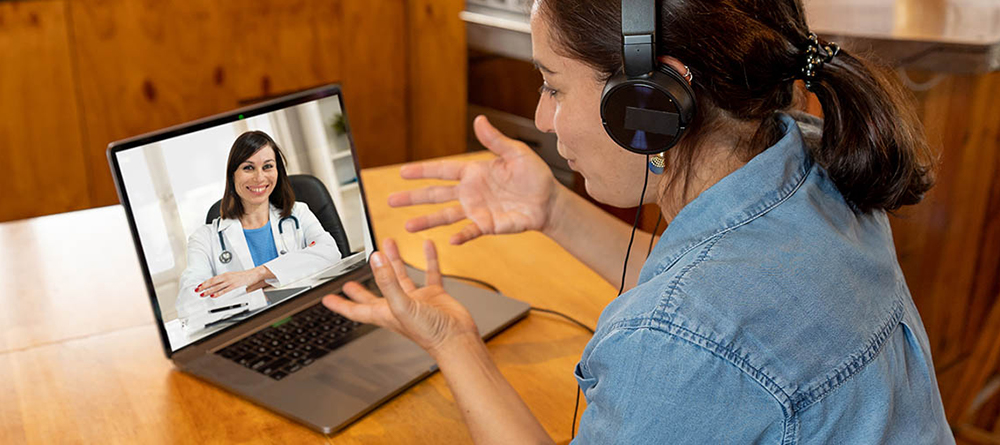Online doctor appointments might not be new, but they went from niche to normal during COVID-19. The growth of telehealth, using digital information and communications to support health care services, has been extensive ever since. Many physicians believe this trend toward more telehealth is here to stay as well.
To gain insight into how remote services have evolved and their potential to change the future of medicine for the better, you might find it helpful to hear some physician perspectives.
Exploring the growth of telehealth in the past
Many of the technologies used to connect patients to physicians and other health care services are recent advances, but telehealth itself isn’t exactly a new concept. In The Role of Telehealth in an Evolving Health Care Environment from the Institute of Medicine, the authors explain that physicians used telephones to provide medical advice to clinics on ships as early as the 1920s. The same article notes that teleradiology, transmitting x-rays or other images taken in one location to a separate location, has been around for decades.

While health care technology to provide remote services has certainly grown since that time, it has been relatively uneven. Mobile apps that allow patients to access test results and send messages to providers, for instance, are standard. Yet many physicians simply didn’t use telehealth previously—at least not often—for a variety of reasons, including some initial hesitancy from patients.
“Reimbursement guidelines were an effective barrier to telemedicine use for both primary and specialty care,” explains Dr. Jacqueline Larson, a pediatric gastroenterologist and St. George’s University School of Medicine (SGU) graduate. The good news is recent policy changes and waivers, some of which are discussed in Implications for Telehealth in a Postpandemic Future, have made remote health care more accessible to patients.
Recent changes in telehealth
Once the pandemic took root in 2020, there was a rapid shift to providing patient care via digital tools. It became the modality of choice for many physicians. In fact, a report on telehealth usage from the Centers for Disease Control and Prevention (CDC) shows there was a 154 percent increase in remote clinical visits from the last week of March 2019 compared to the same period in 2020.

For certain specialties, though, there was already a growing need for more physicians to provide clinical services remotely. According to Doximity’s U.S. Physician Employment Report 2019, there are a number of specialties that are seeing particular demand in the telemedicine job market, including:
- Internal medicine
- Psychiatry
- Radiology
- Family medicine
- Pediatrics
For Dr. Suraj Modi, a child and adolescent psychiatry fellow at the University of South Florida Morsani College of Medicine and SGU graduate, it’s no surprise that psychiatrists fall high on this list.
“We rely heavily on mental status exams, predominantly using observation and trained interpersonal skills in our assessment, as opposed to physical exams requiring physical touch, palpation, auscultation, etc.,” Dr. Modi explains. “I don’t think delivering care through the screen hinders my ability to assess and treat on this basis.”
Patients themselves are also embracing the ability to connect with physicians via their WiFi-enabled devices. Dr. Modi mentions his young patients tend to feel more comfortable being able to reach him from home, and they really appreciate the efficiency as well. He’s not alone in noticing this outlook.
“Telehealth has been accepted by my patients and their families,” Dr. Larson says, also adding, “I can reach a larger geographical area, provide better access to all communities, and spend more quality time with my patients.”

Predictions on how telehealth will impact the future of medicine
While Dr. Modi had little experience with telehealth prior to the pandemic, he fully expects that online doctor visits will continue to be an important part of the way he practices going forward. It would provide benefits to him, such as allowing him to become a licensed practitioner in other states without relocating, while also enabling him to better serve patients.
“Medicine itself is ever-evolving, and so is the way it is delivered to better serve the patient population at large.”
“Medicine itself is ever-evolving, and so is the way it is delivered to better serve the patient population at large,” Dr. Modi says. “Telehealth provides a way to do so, particularly from a mental health standpoint, where wait times to get a provider can take a very long time.”
By better leveraging remote services, there’s even the potential to improve outcomes and the health care system as a whole.
“Telehealth is a promising tool in restructuring care for patients with the most complex of conditions, such as inflammatory bowel disease,” Dr. Larson offers. “This will allow for more personalized, efficient, and value-based health care in the future.”
Leveraging technology to improve care
Perhaps the clearest message to arise from the growth of telehealth is that the future of medicine is bright. Remote services have the potential to drive efficiencies, reduce costs, and even provide better care for underserved populations.
To find out what else can be done to minimize health disparities, read our article “The Importance of Diversity in Health Care: Medical Professionals Weigh In.”

